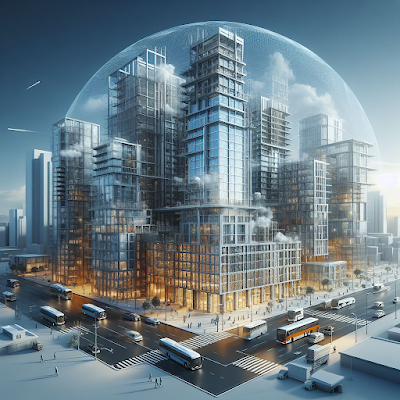Protective Coating: Ensuring Sustainable Infrastructure
In today's fast-paced world, infrastructure development plays a
crucial role in shaping our built environment. From towering
skyscrapers to intricate transportation networks, the durability and
longevity of these structures are paramount. This is where protective
coatings come into play, offering a multifaceted solution that not
only enhances the aesthetic appeal but also ensures the long-term
sustainability of our infrastructure.
At the forefront of
this industry are Industrial Coatings, a specialised category
of materials designed to withstand the harshest of conditions. These
coatings serve as a robust barrier against the relentless onslaught
of environmental factors, shielding surfaces from corrosion,
abrasion, and other forms of degradation. By prolonging the lifespan
of structures, Industrial Coatings contribute significantly to
reducing the carbon footprint associated with frequent replacements
and repairs. From rust-inhibiting primers to durable topcoats, these
coatings are meticulously engineered to withstand the rigours of
industrial environments, ensuring the integrity of critical
infrastructure components.
One crucial aspect
of ensuring infrastructure safety is Fireproofing. In the event of a
fire, the integrity of a building's structural elements is paramount
to preventing catastrophic collapses. Specialised fireproofing
coatings act as a thermal barrier, insulating steel and concrete
components from the devastating effects of extreme heat. These
coatings are meticulously formulated to meet stringent industry
standards, providing peace of mind to occupants and ensuring
compliance with building codes. By slowing the spread of fire
and minimising structural damage, these coatings play a
vital role in safeguarding lives and preserving valuable
infrastructure investments.
Surface preparation
is a critical step in the application of protective coatings, and
Bead Blasting has emerged as a powerful technique in this realm. This
process involves propelling a stream of small, spherical media at
high velocities onto the surface, effectively removing contaminants,
rust, and other imperfections. The resulting pristine surface not
only enhances the adhesion of the coating but also guarantees a
uniform and long-lasting finish. Proper surface preparation is
essential for ensuring the optimal performance and longevity of
protective coatings, making Bead Blasting an indispensable tool in
the industry.
Surface Finishing is
another crucial aspect of protective coatings, as it directly impacts
the aesthetics and functionality of the final product. From glossy
finishes that enhance visual appeal to textured surfaces that provide
improved traction and slip resistance, the options are virtually
endless. Additionally, advancements in nanotechnology have paved the
way for self-cleaning and easy-to-maintain coatings, reducing the
need for frequent maintenance and minimising environmental
impact. These innovative finishes not only contribute to the overall
appearance and functionality of infrastructure but also reduce the
long-term costs associated with upkeep, further promoting
sustainability.
Beyond their
functional benefits, protective coatings have also become an integral
part of sustainable building practises. Many modern coatings are
formulated with eco-friendly ingredients, reducing their
environmental footprint and promoting a greener approach to
construction. Furthermore, the extended lifespan of coated structures
significantly reduces the need for frequent replacements, conserving
valuable resources and minimising waste generation. By
embracing these sustainable coatings, the construction industry can
play a pivotal role in mitigating its environmental impact while
ensuring the longevity of critical infrastructure.
As the world
continues to embrace sustainable practises, the demand for
innovative protective coatings is set to soar. Manufacturers are
continuously pushing the boundaries of technology, developing
coatings that not only offer superior protection but also contribute
to energy efficiency and overall environmental sustainability. One
notable example is the emergence of cool roof coatings, which reflect
a significant portion of solar radiation, reducing the urban heat
island effect and lowering energy consumption for cooling. These
coatings play a vital role in mitigating the impact of climate
change, particularly in densely populated urban areas, by reducing
the energy demand for air conditioning and decreasing greenhouse gas
emissions.
Furthermore, the
integration of smart coatings with embedded sensors and self-healing
capabilities is on the horizon, revolutionising the way we
monitor and maintain our infrastructure. These cutting-edge
technologies will enable real-time monitoring of coating performance,
facilitating predictive maintenance and reducing the risk of costly
repairs or replacements. By leveraging advanced sensors, these smart
coatings can detect early signs of deterioration, allowing for
targeted and timely interventions, minimising downtime
and maximising the lifespan of infrastructure assets.
In
addition to their functional benefits, protective coatings can also
contribute to the aesthetic appeal of infrastructure projects.
Architects and designers can leverage the wide range of colours,
textures, and finishes offered by modern coatings to create visually
stunning and unique structures that seamlessly blend with their
surroundings. This not only enhances the overall appeal of urban
landscapes but also fosters a sense of pride and community ownership,
further promoting the sustainable development of cities.
In conclusion, protective coatings are an indispensable component of sustainable infrastructure development. From Industrial Coatings that safeguard against harsh environments to Fireproofing solutions that prioritise safety, these specialised materials offer a comprehensive approach to preserving our built environment. By embracing the latest advancements in coatings technology, we can create a future where our infrastructure stands the test of time, minimising our environmental impact while ensuring the safety and well-being of generations to come.




Comments
Post a Comment